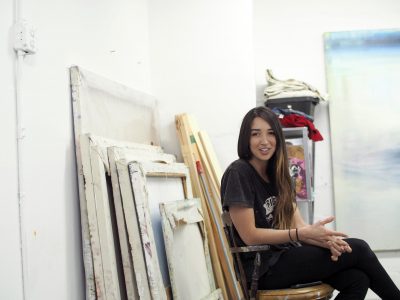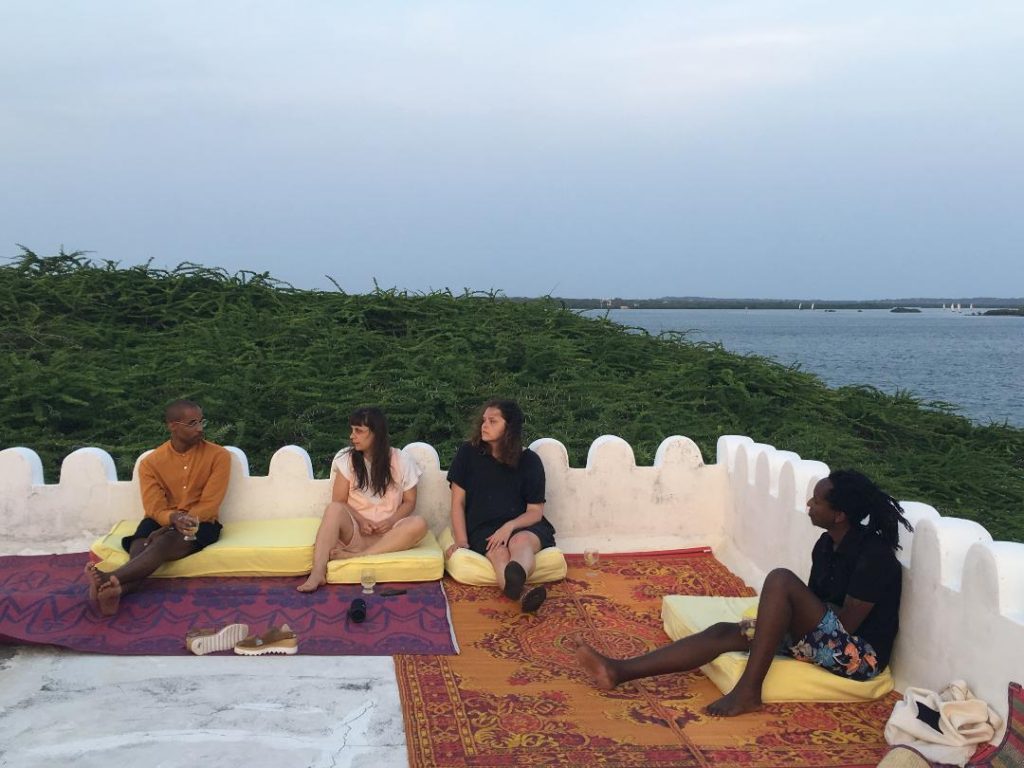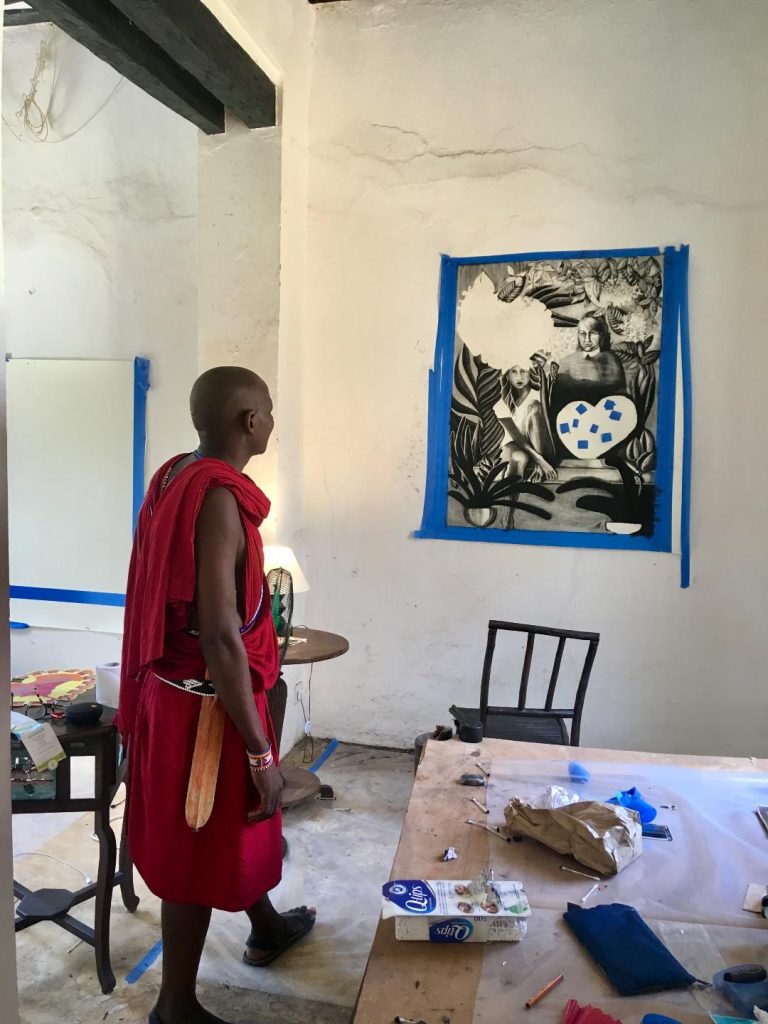Dialogue on Culture and Society. The Voice of a Brazilian Artist
‘Through Painting, I Liberate My Sense of Self from the Restrictive Notions of Gender, Race, and Identity that Surround Me’

Featured image: Marcela Florido in her New York City Studio
Marcela Florido is a young woman visual artist who was born in Rio de Janeiro, Brazil. She has been living and working in New York City for several years. At the time of this discussion she was working as an artist-in-residence on Lamu Island located off the coast of the East African nation of Kenya.
***
Abayomi Azikiwe: What do you perceive as the connection between your work in Brazil, England, the United States and Kenya?
Marcela Florido: At some point in my practice, I realized that the landscapes I depict do not correspond to real space or time. I understand them, instead, as fabricated memories of all the places I’ve called home over the past 10 years. Influences and imagery from personal experience, history books, and mass media layer over one another in my work, each the trace of a larger narrative. Through imagination, then, I question how I inhabit my place-informed identity, as my “home” is constantly redefined.
Azikiwe: How does the racial and political situation in Brazil compare to the U.S?
Florido: During the 90s, Rio was a dangerous place; guns were part of the landscape. As a child, I had an intuitive sense of the violent tension that separated the people in our society, but it seemed like a solvable issue: I was sure the problem wasn’t about the color of our skin or about being Latinos (what does that even mean in your own country?). For my child-self, all we needed was a fair government to dissolve our problems, which I was sure were all caused by economic inequality.
Fast forward to my first days in New York when I was watching an art critique led by a young African American artist whose work addressed the murders of Black men in his home town. He made a point of saying that his work was not in direct dialogue with the western art-historical cannon. It was new and exciting for me to watch the audience, mostly famous white American critics, struggling to follow the conversation on those terms. At some point, I was asked by someone to share my opinion, but the artist replied faster than I could: “She is not part of the conversation. My work is about Black and white America, and she is Latina.”
After 10 years of living abroad, I firmly believe that the violence in Brazil is related to racial issues — and I am deeply interested in interrogating how discourse on identity politics has empowered minority communities in the U.S., while still reinforcing culturally-constructed labels such as “Latina.” It is certainly exciting to see more non-white artists, especially non-white female artists, showing their work in major institutions and investigating the particularities of their experience through art. However, I have also felt reduced to those labels — and I still don’t know what being “Latina” really means.
Azikiwe: In which ways does this impact your creative impulses?
Florido: My work is a product of these contradictory feelings and confusing experiences. Through painting, I establish my own language for thoughts, so I can narrate the experiences that have been carved into my memory and my imagination. Art is a way I can play with, and therefore take ownership of, my femininity, sexuality, and body. Through painting, I liberate my sense of self from the restrictive notions of gender, race, and identity that surround me.
Azikiwe: What constraints, if any, do the influence of racially polarized societies such as Brazil and the U.S impose on your ability to reach broad audiences?
Florido: Artists who show their work internationally are always at risk of being misunderstood. I think that, in the U.S., the contemporary art scene has been so infused with discourses of identity politics that every foreign artist who articulates their subjective bodily experiences is at risk of having their work framed in a reductive manner as being simply about ‘identity’. I feel like I am constantly dodging being pigeonholed into categories such as ‘‘Feminist Brazilian Art,” or, more broadly, “Contemporary Latin American Art.”
I’ve seen so many Brazilian peers sticking to conservative arts practices, such as Geometric abstraction. It seems to me as if they linger in these aesthetics to avoid being constantly exoticized by international audiences — they articulate their own subjectivity without portraying bodies, and in that way avoid opening up their work to the complexes of identity and identification. Personally, I also find this approach restrictive, over-cautious, and, even worse, “race- or identity-blind.
It excites me to explore the conventions of the visual languages artists have developed throughout history, but I am primarily preoccupied with finding freedom within these languages. Art is not all about linguistics: there is something that goes beyond the verbal and allows for ambiguity and fluidity. For me, this tension between limits and freedom is what brings me back to the studio everyday.
Azikiwe: How did you get the opportunity to travel and work in Kenya?
Florido: Tilleard Projects is an art residency that invites artists living in New York to work in the island of Lamu, which lies off the Kenyan coast, for a month. I had been recommended to Caroline Tilleard, the founder of the project, by one of the previous residents, and Caroline thought my work would fit well with that of the two artists who were going to be part of the project in March. She was right: we were a perfect group.
Azikiwe: How conducive is the social atmosphere in Kenya for creative artists?
Florido: As a foreign artist, working in Lamu, which is a UNESCO World Heritage listed site, was truly an amazing and fruitful work experience. The restriction of territory meant that I could explore the island and feel like I was part of the community and the landscape. However, in my studio I would again feel removed, a mere observer. In my daily wanderings, I would almost only see and interact with men. In this predominately Muslim population, they’re the ones working in the town as craftspeople, fisherman and driving the boats at the beach. I cannot imagine what it would be like for a woman from Lamu’s community to be working as an independent artist and pushing against the accepted notions of authority, freedom, gender, and politics.
Marcela Florido on Lamu Island in Kenya with fellow artists during May 2018
Over dinner, the Nairobi-based artist Elias Mungora spoke at length about the contemporary art scene in Kenya and the important role of artist collectives within that community. According to him, it is because of these artist-led efforts that younger female Kenyan artists have been able to show their work and participate in the larger public conversation about art. But he was concerned about the level of interest in Nairobi, explaining that, for many different reasons, locals were still hesitant to go to art openings.
Our conversation made me think about New York’s atmosphere for female artists. During my first year in the city I felt artistically and creatively isolated not only from what was being shown in the mainstream galleries but also from the conversations I was having in some of my peers’ studios. Everyone seemed to have such different concerns, and New York as a whole seemed more like an art scene than an art community. It was then that I founded the artist collective Grupo<> with four other female artists from Latin America. Our aim was to generate critical dialogue about the complexities of art-making, while challenging preconceptions based on gender, geography and skin color. Our projects were grounded by the concerns of artists whose practices are interwoven with the history of Latin America. Grupo<> was a beautiful way of carving out a space in NY where we could have the kinds of conversation that we felt were being silenced by the mainstream art gallery system, and to give us strength to continue in our research.
Azikiwe: What is the political atmosphere now in Kenya which underwent considerable turmoil during the election period of 2017?
Florido: Political messages and graffiti are still visible on the walls of the old town of Shela and Lamu, but the island felt very safe and calm. Through conversations with local friends, I got the sense that during election periods tension and violence tends to rise significantly, so much that many people temporarily leave the country. Throughout history, Kenya (and Lamu in particular) has been shared by several different tribes, and visited by Bantu, Arab, Persian, Indian, Chinese and European traders, all of whom left , and continue to leave, their mark. I was amazed by how often politics were discussed; most people I encountered seemed to have an opinion on the current government and a strong grasp of the political history of the country – and everyone agreed that corruption was a major issue.
Azikiwe: In what way have other artists and the general public responded to your work in Kenya?
Florido: It was great to see local friends casually walking into the studio, even when I was not there, to look at the work and spend time with it. I was very happy with their reaction – which seemed one of curiosity for the stories that I was narrating.
Marcela Florido art work on display on Lamu Island in Kenya
While my earlier work has focused on the allegorical nature of paintings, or even on the discipline of painting, the work that I made in Lamu seemed more personal. In the large-scale drawing Mal-criação, two female figures pose together in a garden for what could be a family photograph; while the younger woman sits on the front, the older woman fades in the background. I also found myself depicting a lushness of atmosphere, that I’d never allow myself in NY – probably in the previously-mentioned attempt at dodging being pigeon-holed. Those labels just don’t apply in Kenya to the same degree, just like they don’t apply to the same degree in Brazil. But most importantly, what made me really happy about working in Kenya was the intimacy I felt between the viewers and my work.
Azikiwe: Thank you so much for your thoughtful responses.
Florido: Thank you so much for giving me the platform to share some thoughts.
*
Marcela Florido is a young woman visual artist who was born in Rio de Janeiro, Brazil. She has been living and working in New York City for several years. From Yale School of Art, she earned a MFA in the Painting Department, New Haven, USA. Her BFA was received from Slade School of Art, London, UK. She also studied at the Foundation in Art and Design, Central Saint Martins, London, UK as well as receiving a Professional Degree in Classical Ballet, Ballet DalalAschar, in Rio de Janeiro, Brazil.
Abayomi Azikiwe is the editor of Pan-African News Wire. He is a frequent contributor to Global Research.
All images in this article are from the author.



